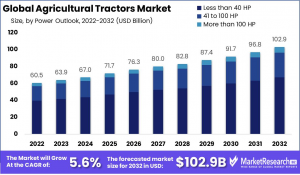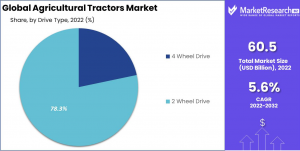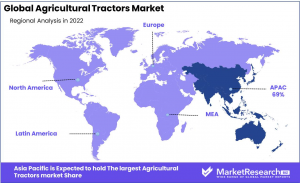Agricultural Tractors Market to Reach USD 102.5 Bn by 2032, Expanding at 5.6% CAGR
Agricultural Tractors Market size is expected to be worth around USD 102.5 Bn by 2032 from USD 60.5 Bn in 2022, growing at a CAGR of 5.6%.
Global Agricultural Tractors Market size is expected to be worth around USD 102.5 Bn by 2032 from USD 60.5 Bn in 2022, growing at a CAGR of 5.6%. during the forecast period from 2023 to 2032.
The Agricultural Tractors Market refers to the industry that deals with the manufacturing, distribution, and sale of tractors used in agricultural applications. These tractors are essential for various farming tasks, including plowing, tilling, planting, and harvesting, which significantly enhance productivity on farms. The market comprises a wide range of tractor models tailored to different scales of farming operations, from smallholder farms to large agricultural enterprises.
The Agricultural Tractors Market has seen steady growth driven by the increasing demand for mechanized farming across the globe. As the agriculture industry evolves to meet the challenges of growing food demand and labor shortages, tractors have become a cornerstone of modern farming. The adoption of advanced technologies such as GPS, automation, and precision farming equipment is also fueling the market's expansion.
Government investments in rural infrastructure and agricultural modernization programs have played a pivotal role in accelerating tractor adoption, especially in emerging markets. Various governments have introduced subsidies, incentives, and credit schemes to make tractors more affordable to small and medium-sized farmers, encouraging further market growth.
Moreover, stricter environmental regulations are shaping the market's future. Policies aimed at reducing emissions and promoting sustainable farming practices are pushing manufacturers to innovate and offer environmentally friendly and fuel-efficient models. Additionally, regulations on safety standards and machinery efficiency are driving continuous improvement in tractor designs, benefitting both farmers and the environment.
The Agricultural Tractors Market presents significant opportunities for both new entrants and established players. For new companies, the increasing demand for advanced, eco-friendly, and cost-effective tractors offers a promising entry point. Moreover, collaborations with technology firms to integrate smart farming solutions into tractors can further enhance product value and appeal to tech-savvy farmers.
Existing players have opportunities to expand their market share by innovating their product lines, focusing on electric tractors, and introducing hybrid models to align with growing sustainability trends. Additionally, companies can tap into emerging markets where mechanized farming is still in its nascent stages, offering tailored solutions for smaller and mid-sized farms. The continuous development of post-sale services, such as tractor leasing and maintenance packages, can further enhance the competitive edge for both new and established companies in this market.
Curious About Market Trends? Request Your Complimentary Sample Report Today: https://marketresearch.biz/report/agricultural-tractors-market/request-sample/
Key Takeaway
--The global agricultural tractors market is projected to grow from USD 60.5 billion in 2022 to USD 102.5 billion by 2032, at a CAGR of 5.6%.
--The under-40 HP agricultural tractors segment dominated the market with a 65.2% share in 2022.
--The 2-Wheel Drive (2WD) segment held a dominant share of 78.3% in 2022, with expected growth driven by low initial costs and improved maneuverability.
--Manual tractors vehicles are predicted to dominate the market, with a strong demand anticipated for manual models due to their ease of handling and lower costs.
--The orchard-type tractors segment is expected to show the fastest growth, driven by their specialized use in fruit orchards and vineyards.
--Asia Pacific led the market in 2022 with a 69% share, primarily driven by India and China, and is expected to maintain its leading position with rapid growth.Market Growth Key Takeaway:
Use Cases
Precision Farming and Increased Productivity
Agricultural tractors are increasingly integrated with precision farming technologies that improve crop yields and optimize land use. Tractors equipped with GPS systems, sensors, and automated controls enable farmers to plant, irrigate, and harvest crops more efficiently. This technology helps reduce costs, increases productivity, and minimizes waste, contributing to the overall growth of the agricultural industry.
Mechanization of Small-Scale Farms
As global demand for food continues to rise, small-scale farms are adopting tractors to replace manual labor and increase efficiency. Tractors offer the ability to till, plow, and harvest larger plots of land in less time. This mechanization of farming operations is helping small farmers boost productivity and compete in an increasingly competitive market.
Farm-to-Market Logistics
Agricultural tractors are essential in transporting goods from farms to markets. The use of tractors for hauling crops, especially in rural areas, enhances the supply chain by reducing delays in delivery. Tractors with higher horsepower and larger load capacities are in demand, allowing farmers to transport large quantities of goods with minimal effort and cost.
Sustainability and Fuel Efficiency
Environmental concerns and government regulations are pushing for the adoption of more fuel-efficient and eco-friendly tractors. Many manufacturers are designing tractors that use alternative fuels or electric engines to reduce emissions and improve sustainability. As consumers and farmers alike are becoming more eco-conscious, the demand for energy-efficient tractors is increasing.
Rental and Shared Farming Equipment Models
With the high cost of purchasing new agricultural tractors, many small-scale farmers are turning to rental or shared farming equipment models. Companies are offering flexible leasing programs that allow farmers to rent tractors for specific seasons or projects. This approach makes it easier for farmers to access the latest technology without the upfront capital investment, increasing accessibility to modern farming equipment.
Driving Factors
Rising Demand for Food Production: With the global population steadily increasing, there is greater demand for food production. This is pushing farmers to adopt advanced machinery, including agricultural tractors, to enhance productivity, automate tasks, and improve efficiency in farming practices.
Technological Advancements in Tractor Features: Modern agricultural tractors now come equipped with advanced technologies like GPS, autonomous driving, and precision farming tools. These innovations allow farmers to optimize fieldwork, improve yields, and reduce costs, thereby boosting the demand for more advanced tractors.
Government Subsidies and Support: Many governments offer subsidies, financial support, or tax incentives to farmers for purchasing modern agricultural machinery. These incentives make it more affordable for farmers to invest in new tractors, fostering growth in the market.
Growing Trend Towards Mechanization in Developing Countries: As developing countries modernize their agricultural practices, the adoption of mechanization, including tractors, is increasing. Farmers in these regions are increasingly moving away from traditional farming methods in favor of more efficient and scalable solutions, driving market growth.
Focus on Sustainability and Precision Farming: With environmental concerns on the rise, the shift towards precision farming is gaining momentum. Tractors equipped with environmentally friendly features such as reduced fuel consumption and lower emissions are helping farmers meet sustainability targets, which is driving demand for such equipment.
Report Segmentation
By Type
• Utility Tractorss
• Row Crop Tractorss
• Orchard Type Tractorss
• Other Types
By Power Outlook
• Less than 40 HP
• 41 to 100 HP
• More than 100 HP
By Drive Type
• 4 Wheel Drive
• 2 Wheel Drive
By Operations
• Automatic Tractors Vehicle
• Manual Tractors Vehicle
Ready to Act on Market Opportunities? Buy Your Report Now and Get 30% off: https://marketresearch.biz/purchase-report/?report_id=20793
Regional Analysis
In 2022, Asia-Pacific dominated the Global Agricultural Tractors Market, holding a 69% market share, with India and China driving growth. The region is expected to maintain its top position, recording the fastest CAGR over the forecast period.
India emerged as the largest contributor within APAC, accounting for 54% of the regional market in 2022. The country recorded approximately 800,000 tractor sales during the year, fueled by favorable agricultural policies, improved monsoon conditions, and financial support mechanisms. Factors such as ease of access to loans, an attractive Minimum Support Price (MSP), and increasing mechanization in farming continue to support market expansion.
With rising government initiatives, technological advancements in agricultural machinery, and growing demand for high-efficiency tractors, Asia-Pacific’s dominance in the global tractor market is expected to strengthen further in the coming years.
Growth Opportunities
Technological Advancements in Tractor Features: The demand for more advanced agricultural tractors with features such as GPS, autonomous driving capabilities, and precision farming tools is increasing. Companies that develop and incorporate these technologies into their tractor models can attract tech-savvy farmers looking for enhanced efficiency and productivity.
Growing Agricultural Mechanization in Emerging Markets: As farming practices in developing countries evolve, there is a growing need for mechanized farming solutions, including tractors. Businesses can tap into emerging markets by offering affordable and durable tractor models suitable for small- and medium-sized farms.
Sustainability and Eco-Friendly Solutions: With increasing awareness of environmental concerns, there is rising demand for tractors that are energy-efficient, low-emission, or even electric. By developing sustainable tractor models, businesses can attract environmentally-conscious farmers and comply with increasingly stringent environmental regulations.
Rising Demand for Food Production: As the global population continues to grow, there is an increasing need to boost food production. Agricultural tractors are essential for improving crop yields and productivity, providing significant growth opportunities in both traditional and new farming regions.
Government Subsidies and Support: In many countries, governments provide subsidies or financial support to farmers for purchasing modern agricultural machinery. Companies can benefit from this by working closely with governments and farmers to make tractors more affordable and accessible, especially in developing regions.
Key Players
• Deere & Company
• SAME DEUTZ-FAHR Group
• Kutoba Corporation
• McCormick International
• Mahindra Group
• Yanmar
• Farmtac
• Massey Ferguson
• Escorts Group
• Kubota
• Other Key Players
Not Sure? Request a Sample Report and See How Our Insights Can Drive Your Business: https://marketresearch.biz/report/agricultural-tractors-market/request-sample/
Conclusion
In conclusion, the markets analyzed are all experiencing growth driven by evolving consumer preferences, technological advancements, and increasing demand for customized, high-quality products. Key trends, such as the adoption of sustainable practices, integration of smart technologies, and rising disposable incomes, are shaping the competitive landscape. While challenges such as market saturation, price sensitivity, and regional differences persist, opportunities abound for companies to capitalize on niche segments, leverage digital platforms, and innovate to meet the specific needs of their target audiences. As these industries continue to expand, businesses that adapt to changing trends, prioritize customer-centric strategies, and invest in innovation will be well-positioned for long-term success.
Lawrence John
Prudour
+91 91308 55334
Lawrence@prudour.com
Legal Disclaimer:
EIN Presswire provides this news content "as is" without warranty of any kind. We do not accept any responsibility or liability for the accuracy, content, images, videos, licenses, completeness, legality, or reliability of the information contained in this article. If you have any complaints or copyright issues related to this article, kindly contact the author above.



